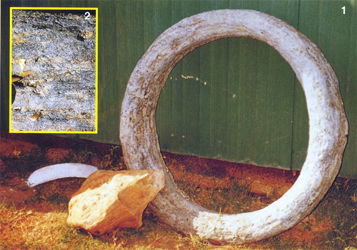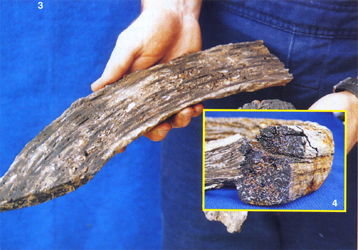Fascinating Fossil Fence-Wire
Originally published in Creation 20, no 3 (June 1998): 6.
The rock is a hard, dense, calcareous sandstone. The wire is ordinary 'Number 8' fencing wire of the type used at nearby Wallal Downs station between 1920 and 1970.
The circular object in photo 1, about 70 cm (2.3 feet) in diameter, was found at Eighty Mile Beach in the north of Western Australia by Amy Lewis, the 11-year-old daughter of the local caravan park owners, Col and Jo Lewis. Exposed at low tide, the object was extremely hard1 and heavy—about 75 kg (165 pounds). On examination, it was obvious even before cutting it open that a roll of modern-day fencing wire had become ‘petrified,’ completely encased in solid rock.
Photo 2 shows the outside surface close up, complete with ‘fossil’ seashells.
Photos 3 and 4 show this wire-containing rock in cross and longitudinal sections.
The rock is a hard, dense, calcareous sandstone. The wire is ordinary ‘Number 8’ fencing wire of the type used at nearby Wallal Downs station between 1920 and 1970.2 Mr Lewis recalls seeing one old wing of fence running into the sea in this spot in the 1970s. The standard practice in the area was that at the perceived end of its life (about 10 years on the coast) fencing wire was rolled into coils like this and discarded, sometimes onto the beach or into the sea.
It is clear that sand, shells and shellgrit accumulated around the wire. Then iron oxide compounds from the rusting wire acted to chemically bind this sandy shellgrit into solid rock around the wire. All of this happened in a few decades, not millions of years.
Unfortunately, the average person is still conditioned into thinking ‘millions of years’ when considering how rocks and fossils form. But as we’ve said many times with many examples—given the right conditions, rocks and fossils will form in a very short time.

Photo 1: The roll of fencing wire in solid rock, shortly after it
was found.
Photo 2 (inset): The very hard surface close up, showing encased
seashells.
Click here
for larger view.

Photo 3: A longitudinal cut surface, clearly showing the lengths
of wire.
Photo 4 (inset): The surface of where the specimen fractured,
showing the circular cross-sections of the wire.
Click here
for larger view.
Footnotes
- The specimen was so hard it ‘rang’ like a bell when struck. Even before the inside was exposed, the visual suspicion that it contained fencing wire was strengthened by the fact that it would attract a magnet. After only a few weeks in the dry air of our air-conditioned Brisbane office, it cracked and sheared cross-sectionally.
- This was during the station’s ‘sheep era,’ when both barbed and plain wire was used. The subsequent fencing for cattle used only barbed wire. Information: Mr Col Lewis, who has lived in the area for many years.
Recommended Resources

Answers in Genesis is an apologetics ministry, dedicated to helping Christians defend their faith and proclaim the good news of Jesus Christ.
- Customer Service 800.778.3390
- Available Monday–Friday | 9 AM–5 PM ET
- © 2025 Answers in Genesis


